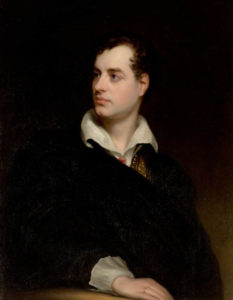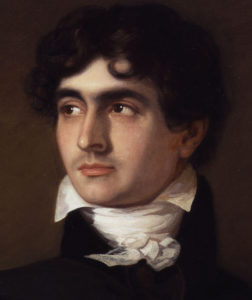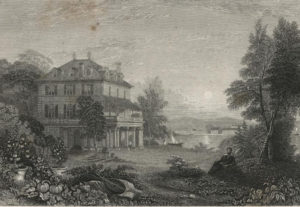I really started becoming fascinated with the Shelley-Byron circle during my English honours year at the University of Sydney. My mother read me the poems of Shelley as a teenager and I had already encountered William Wordsworth and Samuel Taylor Coleridge at school.
The first wave of English literary romantics were interesting enough. Wordsworth with his rambling pastorals somehow beguile the ear. Drug-addled Coleridge enchants with his visions of Xanadu.
But then along came Polly, hanging on to the coattails of the second wave romantics led by Percy Bysshe Shelley, George Gordon Byron and assorted hangers-on.

Shelley and Byron were opium fiends too, maybe not to the same extent as Coleridge, at least judging by contemporary portraits. But the one who fascinates the most (apart from Mary Shelley, Bysshe’s wife and author of the highly influential Frankenstein) is Mr Opium himself – the enigmatic and tortured Dr John Polidori. Ostensibly Byron’s physician, Polidori was Byron’s supplier but took on side-jobs such as managing the accounts. He also wrote a story that became a bestseller and has had as much influence as Frankenstein.
The Vampyre was a forerunner to Bram Stoker’s Dracula, which is why these days we have to put up with so many silly teenagers in TV soaps running around biting people.
The Vampire as aristocrat
Polidori modelled his vampire on Byron himself: the aloof, shadowy and seductive gentleman who goes straight for the neck! Who wouldn’t want to be Byron, who Lady Caroline Lamb famously labelled “mad, bad and dangerous to know.” Mind you, Ms Lamb was pretty mad herself! Byron was the archetypal romantic, forever wandering in mind and body, a seeker, a wit, an unintentional womaniser.

But if I was anyone from that circle in a past life, I was Polidori. In my early years at least I exhibited all his traits: impetuous, jealous, interested in the arts and sciences, ambitious, lacking direction, ungrateful, provocative, self-centred and sensitive. I even look like a bit like him. If only I had his six feet of height too.
The eccentric Polidori did his thesis on sleepwalking. He then decided he wanted to be a poet rather than a doctor, because that is a better way to make a name! If only he knew how unfashionable poetry was to become by the 21st century (a topic for another post).
As a talented grad Polidori secured himself a role as Byron’s personal physician. What this meant is anyone’s guess. One thing is likely though – if they hadn’t fallen out and Polidori hadn’t been fired, Byron might have lived a little longer. Byron died in Greece of the flu (an often fatal illness as recent events are making clear). Doctors bled him with leeches. Western science was still maturing.

Byron and Polidori got off to a good start, galloping across the recently furrowed fields of France where the Napoleonic Wars had raged. They settled at the Villa Diodati by Lake Geneva, where Shelley and his fiancé joined them. Byron and Shelley became BFFs, while Polidori struck up a casual friendship with Mary, spending their days rowing on the lake, probably discussing all sorts of science and fantasy.
Polidori the Enigma
But Polidori was headstrong, and Shelley and Byron (both Peers of the Realm, albeit wayward Peers) did not see him as their equal. This frequently boiled over into resentment, especially when they called him “Pollydolly”.
But they had good times, the most memorable being their ghost story evenings. One of these evenings saw the genesis of Frankenstein and The Vampyre. Plenty has been written on the former. The latter is probably cursed, but as I am already cursed I am free to write about it.
The Vampyre started off as a fragment by Byron, but as soon as Byron ‘let Polidori go’ (due to ‘irreconcilable differences’) Polidori fleshed it out into a full blooded satire on his former employer. He didn’t intend on publishing it, at least not immediately, but the aristocratic lady he was staying with thought it’d be a jolly good joke to push it out under Byron’s name.
It was a hit. Goethe ribbed Byron, knowingly remarking that it was the best thing he had written.
Byron was at pains to distance himself from it. He published his fragment, Augustus Darvell, at the end of his poem Mazeppa. As for the The Vampyre, it was published in multiple languages throughout Europe and plays were staged of it.
Polidori didn’t receive a penny. Quite the opposite. He was accused of plagiarism, which gave free licence to the publishing houses to reap the all profits. After trying to start a new life as a lawyer, Polly suffered a knock to the head in a horse and carriage accident.
Up to his neck in gambling debts, he committed suicide with a chemical concoction of his own making. Possibly not the best solution. I understand his sorrows. But the world lost someone who might have joined the great romantics as a novelist or poet. Or a progenitor of early science fiction.
The legend of John Polidori
His sister Frances married Gabriele Rossetti. Their children, although born after Polidori’s death, were inspired by their adventurous uncle and his travels with Byron. These children were the eminent Christina, Dante Gabriel and William Michael Rossetti.
William once tried to contact his uncle in a seance. One knock for ‘yes’, two for ‘no’. William asked him if he was happy. He received three knocks in reply, which he took to mean, “not really”.
Updated 12 August, 2020
